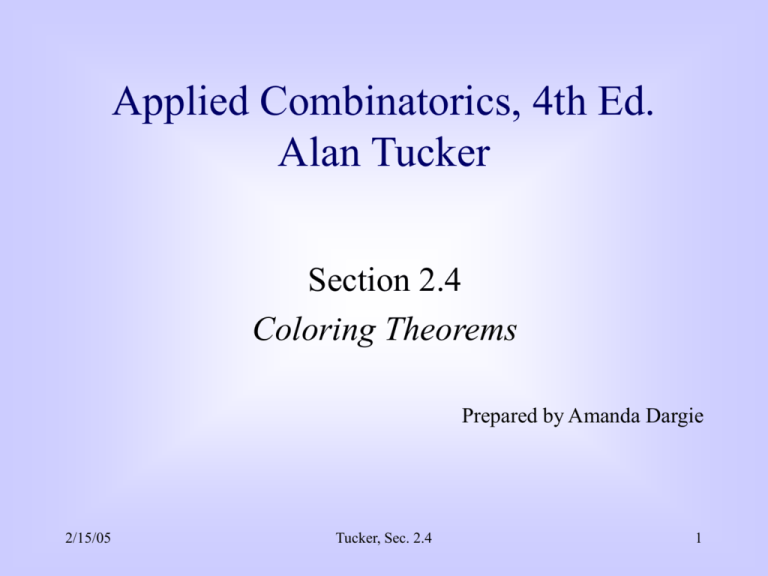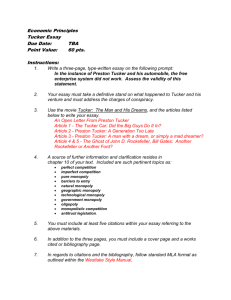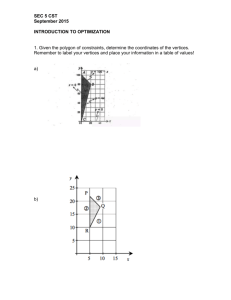Tucker 2-4 - Academics
advertisement

Applied Combinatorics, 4th Ed. Alan Tucker Section 2.4 Coloring Theorems Prepared by Amanda Dargie 2/15/05 Tucker, Sec. 2.4 1 Triangulation of a polygon • The process of adding a set of straight-line chords between pairs of vertices of a polygon so that all interior regions of the graph are bounded by a triangle • [these chords cannot cross each other nor can they cross the sides of a polygon] b a k d j h g c i 2/15/05 f Tucker, Sec. 2.4 e 2 Theorem 1 The vertices in a triangulation of a polygon can be 3-colored. Proof • by induction on n, the # of edges of the polygon • for n=3, give each corner a separate color 2/15/05 Tucker, Sec. 2.4 3 • Assume, any triangulated polygon with less than n boundary edges, n 4, can be 3-colored. •Consider a triangulated polygon T with n boundary edges. • Pick a chord edge e. b a k e d g j h c i f e Note: T must have at least one chord edge since n 4, otherwise T would not be triangulated. 2/15/05 Tucker, Sec. 2.4 4 • This chord e splits T into two smaller triangulated polygons which can each be 3-colored by the induction assumption. e e e e 2/15/05 Tucker, Sec. 2.4 5 • The 3-colorings of the two subgraphs can be combined to yield a 3-coloring of the original triangulated polygon by permuting the names for the colors in one subgraph if necessary. b a e k e e j h d g c i 2/15/05 Tucker, Sec. 2.4 f e 6 Application – Art Gallery Problem What is the smallest number of guards needed to watch paintings along the n walls of an art gallery? •The walls are assumed to form a polygon. •The guards need to have a direct line of sight to every point on the walls. •A guard at a corner is assumed to be able to see the two walls that end at that corner. Note: [r] denotes the largest integer r. Corollary (Fisk, 1978) The Art Gallery Problem with n walls requires at most n / 3 guards. 2/15/05 Tucker, Sec. 2.4 7 Proof • Triangulate the polygon formed by the walls of the art gallery • Observe that a guard at any corner of a triangle has all sides of the triangle under surveillance • Now obtain a 3-coloring of this triangulation. 2/15/05 Tucker, Sec. 2.4 8 • Pick one of the colors (lets pick red) and place a security guard at every red vertex • Now all of the sides of the triangle are watched and therefore all walls of the gallery are watched since every triangle has one red vertex on it • A polygon with n walls has n corners • If there are n corners and 3 colors, then some color is used at n / 3 or fewer corners. 2/15/05 Tucker, Sec. 2.4 9 Definition X(G) = 2 if and only if all circuits have even length. [Let X(G) denote the chromatic number of the graph G.] Recall: (Theorem 2, sec 1.3) a connected graph is bipartite if and only if all circuits have even length Therefore, being bipartite is the same as being 2-colorable. 2/15/05 Tucker, Sec. 2.4 10 Theorem 2 (Brooks, 1941) • If the graph G is not an odd circuit or a complete graph, then X(G) d, where d is the maximum degree of a vertex of G. In this case, the maximum degree of each vertex, d, is 4. Simply, color the non-adjacent vertices the same color (in this case blue) and then the other vertices their own color. 2/15/05 Tucker, Sec. 2.4 11 Theorem 3 (Vizing, 1964) • If the maximum degree of a vertex in a graph G is d, then the edge chromatic number of G is either d or d +1. The edge chromatic number of G is defined as the number of colors it takes to color each edge so no edge incident to the same vertex shares the same color. In this case, the maximum degree of a vertex in G, d = 4 but we need 5 colors for there not to be any edges sharing colors that are incident to the same vertex. Therefore, the edge chromatic number of G is d +1 = 4 +1 = 5. 2/15/05 Tucker, Sec. 2.4 12 Theorem 4 It has already been proven that planar graphs can be 4-colored but since the proof is extremely long and complicated we’re going to look at the next best thing.. Proving that a planar graphs can be 5-colored. • Every planar graph can be 5-colored. 2/15/05 Tucker, Sec. 2.4 13 Proof Recall: (proved in exercise 18, sec. 1.4) any connected planar graph has a vertex of degree at most 5 Consider only connected planar graphs (we can 5-color unconnected planar graphs by 5-coloring each connected part) Assume all graphs with n -1 vertices (n 2) can be 5-colored G has a vertex x with at most degree 5 Delete x from G to obtain a graph with n -1 vertices (by assumption, can be 5-colored) x 2/15/05 x Tucker, Sec. 2.4 14 Proof con’t Then reconnect x to the graph and try to color properly If the degree of x is at most 4, then we can assign x a color different from that of it’s neighbors. If deg x = 5, but only 4 colors are used in coloring x neighbors, then again, x can be colored a 5th color. x 2/15/05 Tucker, Sec. 2.4 15 Proof con’t If deg x = 5 and all 5 colors are used on x’s neighbors, then pick two colors not next to each other (for example, purple and blue) and look at the connected subgraph with those two colors, starting at one of them If they do not hook back to each other (if the purple does not hook back to the blue by a path of alternating purple and blue) then switch the colors on that piece (switch purple to blue and blue to purple) Now color x the color not adjacent to it. 2/15/05 Tucker, Sec. 2.4 16 Proof con’t If the two colors hook back (if blue and purple hook back) then pick two other colors not next to each other (let’s pick green and pink) We know that green and pink cannot hook back to each other because in order to they would need to cross the blue-purple path and the graph would no longer be planar 2/15/05 Tucker, Sec. 2.4 17 Proof con’t Switch the green and pink on one section of the graph so that x now becomes adjacent to two vertices of the same color Now, since x’s 5 neighbors share only 4 different colors, color x the 5th color. 2/15/05 Tucker, Sec. 2.4 18 For the class to try: Show that a planar graph G with 8 vertices and 13 edges cannot be 2-colored. Hint: Use results in Section 1.4 to show that G must contain a triangle. 2/15/05 Tucker, Sec. 2.4 19 Solution By using Euler’s Formula, r = e – v + 2, we know that any graph with 8 vertices and 13 edges must have r = 13 – 8 + 2 = 7 regions and therefore must contain a triangle. We know that a triangle can be at smallest, 3-colored, and therefore this graph cannot be 2-colored. 2/15/05 Tucker, Sec. 2.4 20







